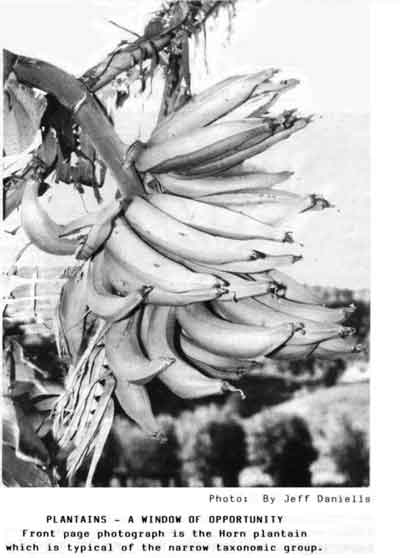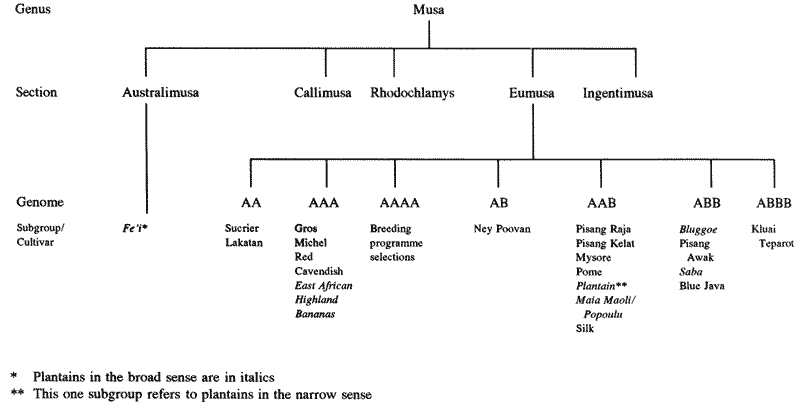
PLANTAINS - A WINDOW OF OPPORTUNITY
SCIENTIFIC NAME: Musa species
FAMILY: Musaceae

What makes a plantain a plantain?
Plantains are often thought of as being totally distinct from bananas but in reality they are just a type of banana which is cooked before consumption. 'Bananas' is used to describe all members of the genus Musa. Plantains, in the broad sense, include all members of the genus Musa that are starchy at ripeness. More specifically, plantains refer to a defined taxonomic group within the genus which have the AAB genome, orange-yellow colour of both the compound tepal (petal) of the flower and the fruit pulp at ripeness and fruits which are slender, angular to pointed, and are generally palatable only after cooking.(Figure 1) Horn Plantain is typical of the narrow taxonomic group. Varieties such as Bluggoe are included in plantains in the broad sense.
Plantains very significant on world scene
Plantains are grown extensively throughout the tropical regions of the world. Plantain production is most significant in East and West Africa as well as South America. In these regions plantains are a major staple of the diet with 200 - 300kg consumed per person per year. Plantains are also a very significant part of the diet throughout much of S.E. Asia and the Pacific. When grouped with bananas, plantains represent one-third of the combined production.
A significant niche market opportunity exists for plantains in Australia and overseas. This has been brought about by the ever-increasing ethnic market. As well, many more Australians have travelled, they want more choices and have the money to spend. Current production in Australia from not much more than 10 hectares goes nowhere near meeting the potential demand.
Figure 1

Table 1. Characteristics of plantain varieties at South Johnstone in 2 experiments.
| Variety | Bunch Wt (kg) | Days Planting to Harvest | 3rd Hand Finger Length (cm) | Pseudostem Height (cm) |
| Experiment 1 (Average of plant crop and 2 ratoons) | ||||
| Williams (Check) | 50.7 | 328 | 28.5 | 290 |
| Pacific Plantain | 30.5 | 307 | 30.7 | 343 |
| Horn Plantain | 18.3 | 322 | 33.2 | 361 |
| Bluggoe | 17.6 | 353 | 25.0 | 364 |
| Experiment 2 (plant crop only) | ||||
| Williams (Check) | 30.5 | 373 | 29.0* | 191 |
| Dwarf French Plantain | 21.8 | 441 | 28.2* | 246 |
| Mangaro Torotea | 34.8 | 421 | 26.2* | 364 |
| *Hand 2 | ||||
Plantains evaluated at South Johnstone
QDPI has evaluated a large number of plantains at South Johnstone Research Station. Some yield data from the trials is shown in Table 1. The plantains are much lower yielding than Williams, a Cavendish-type banana. Therefore you need to get higher prices for plantains for them to be as profitable to grow as Cavendish-type bananas. Varieties such as Pacific Plantain, Horn Plantain and Bluggoe have been around for some time. Newer varieties are yet to be released. The most promising of these are Dwarf French Plantain, Mangaro Torotea, Pisang Gajih Merah (≈Saba) and Monthan.
Market development essential for increased sales
In Australia, horticultural producers generally have a reputation of selling produce rather than marketing. However the selling approach is not well-suited to the market development of new varieties. Market research is needed to determine what quantity of what varieties are required when, by whom, at what price and the product promotion necessary. Good marketing holds the key to significant continued sales of plantains.
The large ethnic Asian/Pacific population in Australia is obviously one target for plantains (Table 2). Because this population is already accustomed to many of the plantains, marketing should be greatly facilitated.
Another marketing target would be the hotel and restaurant trade. Plantains are much better-suited to cooking because of their firmer flesh, which makes them ideal for desserts.
Plantains have better prospects for export than Cavendish bananas. Direct competition is avoided with fruit produced overseas where the labour is cheaper. The very large ethnic Polynesian population in New Zealand is an apparent niche market opportunity for plantains.
Table 2. Number of migrants from selected Asian/Pacific countries
resident in Australia, 30 June 1976 and 30 June 1991.
| Number of Residents | ||
| Country | June 1976 | June 1991 |
| Vietnam | 2500 | 133 444 |
| Malaysia | 19900 | 84089 |
| Philippines | 5800 | 74328 |
| Hong Kong & Macau | 8900 | 73207 |
| China | 20 100 | 68514 |
| India | 39200 | 65426 |
| Sri Lanka | 15 600 | 38884 |
| Indonesia | 9500 | 33549 |
| Fiji | 5900 | 29630 |
| Singapore | 9 100 | 29325 |
| Papua New Guinea | 15400 | 24303 |
| Other Pacific Islands | 4700 | 22 124 |
| Cambodia | 500 | 18667 |
| Thailand | n.d.* | 12313 |
| TOTAL | 157 100 | 707 803 |
| % of Australian Population | 1.1 | 4.1 |
| * n.d. = not determined Source Australian Bureau of Statistics | ||
Plantains - Ideal as a vegetable side-dish or dessert
Plantains are cooked while still green (unripe) and eaten as a starchy food source in several countries in much the same way as potatoes or rice are consumed. Semi-ripe fruit of Saba and Pacific Plantain are excellent boiled or barbecued and make an interesting change as a vegetable.
Plantains probably appeal most to the western palate when allowed to ripen and then fried and served as a dessert with fresh cream or ice cream.
A word of caution
Most plantains are more resistant to leaf spot disease than Cavendish. However, several of the plantains are susceptible to Races 1 and 2 of Fusarium wilt (Panama disease). This disease is primarily spread in infected planting material. Remember, you will no longer be able to grow a susceptible variety once you have had the disease, because the fungus can persist in the soil for many years even without a banana host plant present.
When planting bananas, a permit is required. These can be obtained from the QDPI. This helps ensure that Panama disease is not spread further.
DATE: July 1994
* * * * * * * * * * * * *
